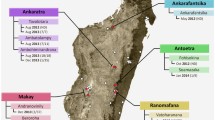Abstract
Chytridiomycosis is a fatal disease of amphibians, caused by the amphibian chytrid Batrachochytrium dendrobatidis. The disease is unusual in that it may drive many amphibian species to local extinction during outbreaks. These dramatic declines in host population numbers could be facilitated if the pathogen can grow as a saprobe or on alternative hosts, a feature common to other chytrid species. This is also supported by in vitro work that demonstrates B. dendrobatidis can grow and reproduce in the absence of amphibian cells. In a previous study, B. dendrobatidis was detected on freshwater shrimp from rain forest streams in northern Queensland, Australia, using diagnostic PCR. We set out to confirm and further investigate the presence of B. dendrobatidis on crustaceans by carrying out more extensive sampling of shrimp in the field, experimental B. dendrobatidis infection trials using shrimp and crayfish, and PCR verification of the presence of B. dendrobatidis from shrimp samples that previously tested positive. We could not confirm the presence of B. dendrobatidis on shrimp, and report that original positive tests in shrimp reported by Rowley et al. (2006) were likely false. Thus, we suggest that shrimp may not be an important reservoir host for B. dendrobatidis.
Similar content being viewed by others
References
Annis SL, Dastoor FD, Ziel H, Daszak P, Longcore J (2004) A DNA-based assay identifies Batrachochytrium dendrobatidis in amphibians. Journal of Wildlife Diseases 40:420–428
Berger L, Marantelli G, Skerratt LF, Speare R (2005) Virulence of the amphibian chytrid fungus Batrachochytrium dendrobatidis varies with the strain. Diseases of Aquatic Organisms 68:47–50
Berger L, Speare R, Daszak P, Green DE, Cunningham AA, Goggin CL, et al. (1998) Chytridiomycosis causes amphibian mortality associated with population declines in the rainforests of Australia and Central America. Proceedings of the National Academy of Sciences of the United States of America 95:9031–9036
Boyle DG, Boyle DB, Olsen V, Morgan JAT, Hyatt AD (2004) Rapid quantitative detection of chytridiomycosis (Batrachochytrium dendrobatidis) in amphibian samples using real-time Taqman PCR assay. Diseases of Aquatic Organisms 60:141–148
Cobb BD, Clarkson JM (1994) A simple procedure for optimising the polymerase chain reaction (PCR) using modified Taguchi methods. Nucleic Acids research 22:3801–3805
Covich AP, Crowl TA, Johnson SL, Pyron M (1996) Distribution and abundance of tropical freshwater shrimp along a stream corridor: response to disturbance. Biotropica 28:484–492
Covich AP, Crowl TA, Johnson SL, Varza D, Certain DL (1991) Post-hurricane Hugo increases in atyid shrimp abundances in a Puerto Rican montane stream. Biotropica 23:448–454
Daszak P, Berger L, Cunningham AA, Hyatt AD, Green DE, Speare R (1999) Emerging infectious diseases and amphibian population declines. Emerging Infectious Diseases 5:735–748
Godfray HCJ, Briggs CJ, Barlow ND, O’Callaghan MO, Glare TR, Jackson TA (1999) A model of insect-pathogen dynamics in which a pathogenic bacterium can also reproduce saprophytically. Proceedings of the Royal Society of London. Series B: Biological Sciences 266:233–240
Johnson ML, Speare R (2003) Survival of Batrachochytrium dendrobatidis in water: quarantine and disease control implications. Emerging Infectious Diseases 9:922–925
Johnson ML, Speare R (2005) Possible modes of dissemination of the amphibian chytrid Batrachochytrium dendrobatidis in the environment. Diseases of Aquatic Organisms 65:181–186
Kriger KM, Hero J-M, Ashton KJ (2006) Cost efficiency in the detection of chytridiomycosis using PCR assay. Diseases of Aquatic Organisms 71:149–154
Lips KR, Brem F, Brenes R, Reeve JD, Alford RA, Voyles J, et al. (2006) Emerging infectious disease and the loss of biodiversity in a neotropical amphibian community. Proceedings of the National Academy of Sciences of the United States of America 103:3165–3170
Longcore JE, Pessier AP, Nichols DK (1999) Batrachochytrium dendrobatidis gen. et sp. nov., a chytrid pathogenic to amphibians. Mycologia 91:219–227
McCallum H, Dobson A (1995) Detecting disease and parasite threats to endangered species and ecosystems. Trends in Ecology and Evolution 10:190–194
McCallum H, Dobson A (2002) Disease, habitat fragmentation and conservation. Proceedings of the Royal Society of London. Series B: Biological Sciences 269:2041–2049
Nichols DK, Lamirande EW, Pessier AP, Longcore JE (2001) Experimental transmission of cutaneous chytridiomycosis in dendrobatid frogs. Journal of Wildlife Diseases 37:1–11
Powell MJ (1993) Looking at mycology with a Janus face: a glimpse of chytridiomycetes active in the environment. Mycologia 85:1–20
Rowley JJL, Alford RA, Skerratt LF (2006) The amphibian chytrid Batrachochytrium dendrobatidis occurs on freshwater shrimp in rain forest streams in northern Queensland, Australia. EcoHealth 3:49–52
Schloegel LM, Hero J-M, Berger L, Speare R, McDonald K, Daszak P (2006) The decline of the sharp-snouted day frog (Taudactylus acutirostris): the first documented case of extinction by infection in a free-ranging wildlife species. EcoHealth 3:35–40
White TJ, Bruns T, Taylor J (1990) Amplification and direct sequencing of fungal ribosomal RNA genes for phylogenetics. In: Innis MA, Gelfand DH, Sninsky JJ, White TJ (editors), PCR Protocols: A Guide to Methods and Applications, San Diego, CA: Academic Press, pp 315–322
Acknowledgments
This research was supported by funding from the Australian Geographic Society; the Society for the Study of Amphibian and Reptiles; the Peter Rankin Trust Fund for Herpetology; the Australian Government Department of Environment and Heritage; the US National Science Foundation Integrated Research Challenges in Environmental Biology grant DEB-0213851; and the US National Science Foundation and Australian Academy of Science’s East Asia Summer Pacific Institute, and was carried out under a Scientific Purposes Permit issued by the Queensland Parks and Wildlife Service (WISP01715204), as approved by the James Cook University Animal Care and Ethics Committee (A863). J.J.L.R. was supported by an Australian Postgraduate Research Scholarship. Kathy La Fauce and Leigh Owens provided the crayfish and technical support for the experimental infections. Numerous volunteers assisted in the field.
Author information
Authors and Affiliations
Corresponding author
Rights and permissions
About this article
Cite this article
Rowley, J.J.L., Hemingway, V.A., Alford, R.A. et al. Experimental Infection and Repeat Survey Data Indicate the Amphibian Chytrid Batrachochytrium dendrobatidis May Not Occur on Freshwater Crustaceans in Northern Queensland, Australia. EcoHealth 4, 31–36 (2007). https://doi.org/10.1007/s10393-006-0075-z
Received:
Accepted:
Published:
Issue Date:
DOI: https://doi.org/10.1007/s10393-006-0075-z




